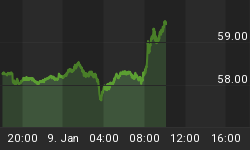Last month in my regular InvestorIntel column, I discussed the idea of striving to become an intentional trader who was willing to take calculated risks in the market, rather than simply a gambler's toss of the dice. (A quick perusal of that article here will give you a clearer picture of what I will be discussing today.) By definition, any position in the market risks losing money - possibly 100% of the committed funds. This is where people get emotionally and financially into trouble, if for example they perceive the position they took is "sure-fire" or that it's possible to reap large gains without taking a certain - perhaps a substantial - amount of risk.
In that article, I used the charts of two companies, Tahoe Resources (a silver producer in Guatemala), and Pretium Resources (a gold exploration company in northwestern B.C.). These two companies were selected primarily because of what we might be able to learn, looking at their charts from a conceptual basis, about trading and handling price risk.
Both companies experienced big price breaks to the downside. Tahoe (taking place several months earlier) had retraced its price break to the upside. At this writing, it demonstrates that a person who took a position near the lows and held on would now be looking at potentially, a pretty decent profit.
Pretivm Resources suffered two price breaks, and indeed had traded down well below its market entry price from a couple of years ago. As was reported earlier, this event was ostensibly due to a disagreement between Pretium and one of the two mineral services companies evaluating its bulk sample drill program results.

Pretium Resources (NYSE: PVG) Daily on 10.30.13
Then just few weeks later (after prices proceeded to decline another 20%) Pretium announced results with the 8,000 dry tonnes of excavated material from their Valley of the Kings Bulk Sample Program. The results exceeded their own expectations, and with a one day rise in the share price of almost 79%, the market, on that particular day apparently agreed.

Pretium Resources Daily on 11.22.13
How it could have been played
So how might the "bold but calculated" investor play this kind of chart pattern? Remember we are focusing here on the concept of the chart action, rather than the company itself. (Your decision regarding a particular company would of course involve doing additional research to see if the merits warranted taking a position, regardless of the perceived chart formation).
A couple of strategies come to mind. First, if an investor had a built a long-term core position established considerably higher, they might have protected against a severe decline - the way many trading coaches advise - with a stop-loss, of say 20 - 25%. A person doing this would have been taken out on the first big price break below $7. (Then depending upon individual risk tolerance and doing more research on the company, they might have decided to re-establish the position at a lower price.)
Many analysts feel that a person should NEVER risk more than 25% on a position, and there is certainly a lot of evidence to support this view, a case in point being looking at the last year's decline, wherein many gold and silver producers have dropped 40 - 70% from their 2011 highs. And of course for explorers, the declines have often exceeded 90%!
However, a core position holder may have taken the view that they would hold what they consider to be good companies, regardless of how far down the price might drop, before it resumes what the investor anticipates would be an even greater long-term price rise. Ideally this investor would have decided beforehand, whether or not they would be willing and able - financially and psychologically - to commit further, on a dollar cost averaging down basis.
Looking at the second chart above, this person might have added to his/her position down into the $5 area, and again around $4...or even lower. This strategy could well lead to a complete loss of funds - as has been the case for many investors who bought undercapitalized/unsuccessful exploration stocks since 2011. But at least it would be an intentional plan, with the decision made up front that the potential of losing all committed funds was an acceptable risk to take.
Further, this investor might have sold back some of his trading position into the unexpected 80% one day up-move, with the anticipation of being able to buy it back on, say a 50% decline.
Rick Rule is willing to take large, calculated risks - and has the patience to hold his positions for 3-5 years if necessary. On several occasions, he has been able to add to positions during market extremes and then cash out a few years later for 5 - 10 times his money. Recently, Rick said this:
"Once in a decade, natural resource markets fall by at least 50%. The best investors lose half their money even though they have the best positions. At the bottom the best investors sell the worst of their stocks and redeploy the money among the remaining companies. When markets recover, those portfolios can be up dramatically, compensating them more than handsomely for their courage in the bear market days."















